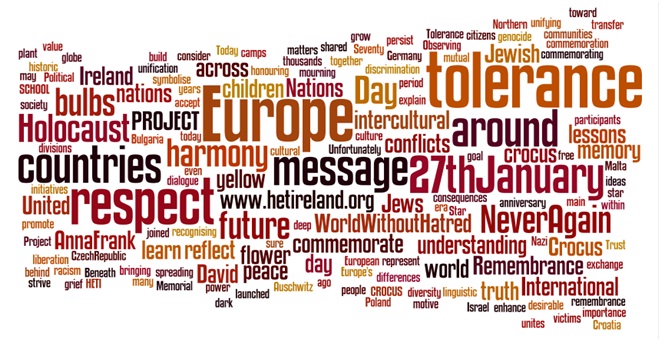II. osnovna škola Čakovec, Croatia
Genocide, the Holocaust and War Crimes
a report
Student: Filip Novak
Age: 14
Teacher: Snježana Odak-Hrkač
Knezovec, March/April 2013
Translation from Croatian into English
Student: Petra Grašić
Age: 14
Teacher: Branka Lamza
Čakovec, June 2013
Introduction
The holocaust is definitely the
biggest indicator of nazi terror and all its ideologies: racism, antisemitism,
pangermanism and one of the biggest indicators of genocide and human stupidity
which repeats itself over the course of history. "Two things are infinite: the
universe and human stupidity; and
I'm not sure about the universe.“[1]
The word ''holocaust'' originates
in antic Greece and means burned completely , and today it signifies the mass persecution
of Jews and all others who were not thought of as aryan by the Nazis.
In that crime against humanity, 6 million Jews paid for their religion with their lives, while the others, who survived, were subjected to horrid physical and psychological hardships.
In that crime against humanity, 6 million Jews paid for their religion with their lives, while the others, who survived, were subjected to horrid physical and psychological hardships.
Topic development
After an attempt at a coup in
Munchen, Hitler was put in prision, where he wrote the book Mein Kampf (My Fight), which became the foundation of
nacism and which puts a lot of stress on nazi and antisemitistic ideologies.
Before Hitler came into power, his ideas were thought of a laughing matter, chaotic and crazy, but when he did come into power, he started commiting genocide on all ethnicities that did not fit into his idea of the world and what a man should be.
In1935, in
a convention in Nurnberg, anti-Jew laws were put into place.
Before Hitler came into power, his ideas were thought of a laughing matter, chaotic and crazy, but when he did come into power, he started commiting genocide on all ethnicities that did not fit into his idea of the world and what a man should be.
In
In the night between the 9th and
the 10th November 1938, the most until-then horrific crime against Jews took
place. In one night thousands of Jews were murdered or taken away into
concentration camps. Many Jewish buildings (houses, shops and synagogs) were
destroyed.
In November 1939 in Poland, and later
in many other countries, a law was put into place by which all Jews must wear a
yellow Star of David on which the word ''Jude'' was written. Such stars were
meant to serve as a marking of race.
Jews were placed in special,
isolated parts of cities they resided in (ghettos), the biggest of which was
the Warsaw ghetto, where a Jew rebellion happened.
On 20th January1942 in
Wansee another decision was made, stating that the Final Solution is to be put in place, signaling
the murders of 11 million European Jews. Millions of Jews were arrested and
taken into concentration camps, where they were brought to work as slaves. To
speed up the results of the Final
Solution, the nazis founded 6 death camps, the biggest of which was Auschwitz-Birkenau. That horrid
genocide ended in 1945., at the end of
World War 2 and took over 6.5 million lives, including Anne Frank's, who
was in hiding from the Gestapo with her
family and wrote a diary
describing the gruesome everyday life during the occupation of the Netherlands.
„One day this
war will end. There will be a time when we willl be people again, not just
Jews.“[2] The
rememberance day of the holocaust and stopping crimes against humanity is on
27th January, on the anniversary of freeing Auschwitz.
On 20th January
Conclusion
Not only is the holocaust one of
the most terrifying genocides and racist acts in human history, its horrible
consequences can be felt even today, seventy years later. It left permanent
consequences, wounds that will never fully heal. A man ruined another man's
life, acted towards him as though we was worthless, made him feel as if he
truly was, killed his family and friends just because he didn't like him, because he
wasn't what he imagined, and that is, in my opinion, disgusting and inhumane. „Non-violence leads to the highest ethics,
which is the goal of all evolution. Until we stop harming all other living
beings, we are still savages.“







